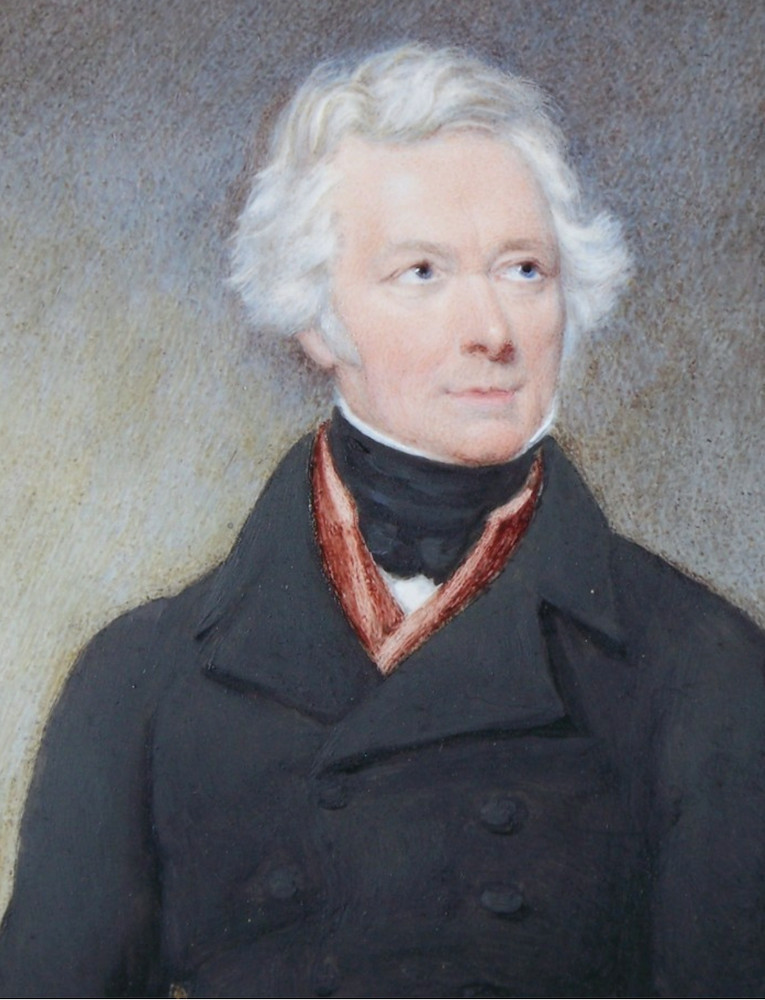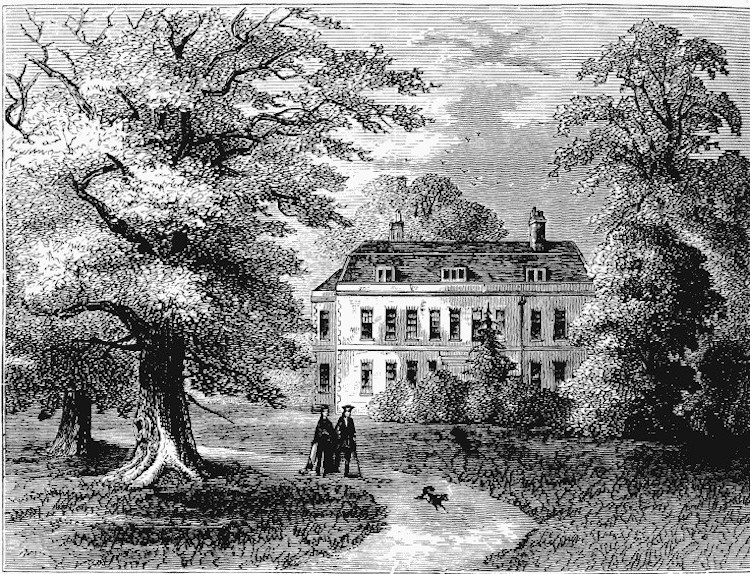
Portrait of Henri Fradelle
by Moses Haughton the Younger (1848),
by kind permission of the author.
This is a brief extract from my monograph about Henri Fradelle (1778-1865). Fradelle, one of my ancestors, was a Franco-English Victorian artist specializing in portraits as well as literary, historical, and religious subjects. Born in Lille, and raised in France, where he was a student of Joseph-Benoit Suvée at the Académie royale in Paris, Fradelle then spent eight years in Italy before living much of his life in England. Since I have studied people with two or more languages for many years, and have lived in several countries myself, including Fradelle's, I was inspired to find out more about him. Over a span of some twenty years, I resolved the mystery of the erroneous name my ancestor had been given by earlier biographers (Henry Joseph Fradelle), reporting this in an article for Art of England; I also hunted down his more than 100 paintings spread across the world, and delved further into his fascinating life story. Please see the bibliography for a link to my monograph, which covers a life well filled, and also contains an exhaustive list of his paintings, together with a selection of reproductions of his work.
Introduction to the extract
It was only at the age of 38, when he arrived in England for the first time, that Fradelle's career took a sudden, and successful, turn with his many paintings of historical and literary subjects presented at the British Institution and at the Royal Academy, most of them reproduced as prints by respected engravers at the time. He attempted to resettle in France in the early 1830s - he was in his 50s by then - but only stayed a few years before coming back to England. For the last twenty five years of his life, this became his adopted country.

Fradelle's Othello Relating the Story of His life to Brabantia and Desdemona, 1824. Courtesy of the Royal Shakespeare Company Collection. Photograph by the author.
Extract
Fradelle had come back with several paintings from Italy and started exhibiting once again at the British Institution and at the Royal Academy Summer Exhibition. In 1838, at the British Institution, he presented a more recent, and larger, version of Raphael and the Fornarina (the first one had been exhibited on his arrival in England in 1817). The Literary Gazette gave it a short but good review: "Carefully painted. The figure of the Fornarina is singularly beautiful and attractive." Then in 1839, at the British Institution, Fradelle presented another four of his Italian paintings, reminding one of his "surge" of paintings exhibited when he had just arrived in England for the first time and, some fourteen years later, when he had just arrived back in France. This time, interestingly, he gave these paintings Italian titles and did not attempt to translate them: L'Aspettatrice; Il Ritorno della Fontana; Il Solleticare; and La Lezione di Piffero.
A few years later, in 1847, he exhibited a fifth Italian painting with the title Souvenirs d'Italie – Il Sospiro, an Italian dance – a view of l'Ariccia near Albano in the distance.... It is a rare group scene, in this case a dance with many participants. Apart from these Italian works, and a few literary paintings such as An Incident in Milton's life when a student at Cambridge, etc. (Royal Academy, 1839; British Institution, 1840) and a second version of Othello and Desdemona (British Institution, 1849), Fradelle concentrated mainly on portraits exhibited at the Royal Academy such as Mrs. Jeffery (1837) and (1847).
In addition to continuing painting, Fradelle was consulted for his expertise as a connoisseur of fine art. An example comes from the exchange he had with the members of the Select Committee on Fine Arts at the House of Commons on June 11, 1841, concerning the decoration of the New Houses of Parliament. The extract presented below is interesting as the report it comes from is the only instance I have found of Fradelle expressing himself for any length of time in English. He does so beautifully, as can be seen. After a short opening question and answer (Chairman: ARE you an artist? - I am), the topic discussed was mainly on the advantages and disadvantages of fresco painting vs. oil painting in buildings:
881 Question: Why do you prefer oil painting to fresco on a large scale?
Fradelle: First, on account of the climate; I have observed, for example, in Rome, that the frescos, by Raphael, in the palace of the Farnesina, which is near the Tiber, certainly in a very damp situation, are not by far so well preserved as those in the Vatican.
889 Question: Would it not be an objection that in buildings somewhat dark, as the new Houses of Parliament would be, the oil paintings would withdraw a greater quantity of light than the fresco paintings?
Fradelle: It is important that the artist should study the light for which he paints. If an artist has to decorate a portion of a wall that receives very little light, of course he must take that into account, so that it may be calculated to produce effect with the light that he can obtain.
890 Question: Why is it that the modern Germans prefer the fresco for ornamenting their buildings?
Fradelle: I cannot tell what is the reason for choosing that style; but if the artist considers what is the place that his picture is to be placed in when he paints it, of course he would regulate the colour in proportion....
891 Question: Do you consider that they prefer oil or fresco, for the large works in France?
Fradelle: They prefer oil; if I bring your attention to the palace at Versailles, which was painted by Lebrun, the pictures there are perfectly kept. The modern embellishments in the Louvre have been all painted in oil.
Fradelle's vast knowledge, and mastery, of drawing and painting was also called upon by the Putney College for Civil Engineers, established in 1840, in a lovely mansion called Putney House.

Putney House, 1810, from Cassell's Old and New London 6: 492 (public domain).
He was appointed Professor of drawing and painting and taught a course entitled, "Perspective and free-hand drawing" and later, simply, "Drawing." The aim of the College was to confer to students a superior education in engineering, mathematical and mechanical sciences. Things went smoothly, and Fradelle even put an advertisement in the Morning Herald titled, "To schools and families in the vicinity of Fulham and Putney," stating that he was "desirous of devoting one or two leisure hours to instruction in the above branches of art on those days of his attendance at Putney House." It is not sure whether he found one or several students to teach in the end. His View of Putney College, a watercolor, was auctioned by Mssrs. Christie, Manson & Woods (London) in 1873, but it has disappeared since.
Fradelle's last exhibition at the British Institution took place in 1849 with Othello and Desdemona and Innocence and Happiness. He continued a few more years at the Royal Academy Summer Exhibition with two portraits in 1854 (Captain Basset, R.A. and Portrait of the son of W. T. Barnes, Esq. ... ) and a final one in 1855 (Youngest son of the late W. T. Barnes, Esq.). In the end, the span of years he had exhibited at the British Institution went from 1817 to 1849, and that at the Royal Academy of Arts from 1817 to 1855, quite a feat for an artist who had come from abroad in 1816 at the age of 38.
One of Fradelle's last works, which has only reappeared lately, is of a scene which has been titled Monastery Peace. It is dated 1855 and was put up for auction by the Hargesheimer Kunstauktionen in Düsseldorf in 2019. It is a perfect pictorial ending for an artist who started his career in Italy with several religious paintings such as Un claustro dell'ospedale militare di Sant'Ambrogio which is now part of the permanent collection at the Accademia di Belle Arti di Brera in Milan.
Links to Related Material
- The Subjects of Victorian Painting
- William Holman Hunt on the frescoes and other paintings in the Houses of Parliament
Bibliography
Grosjean, François. "Fradelle: The Artist who was Given His Son's Name." Web. 1 July 2025.
_____. In Search of Henri Jean-Baptiste Victoire Fradelle. Web. 1 July 2025.
Created 1 July 2025